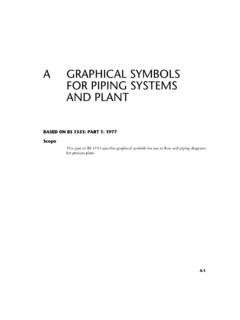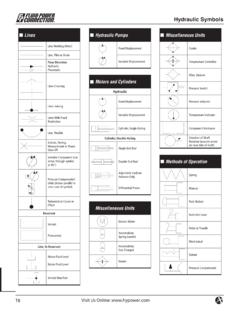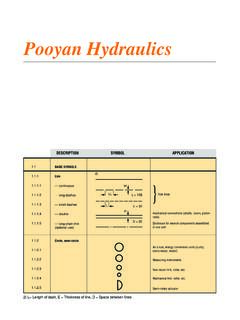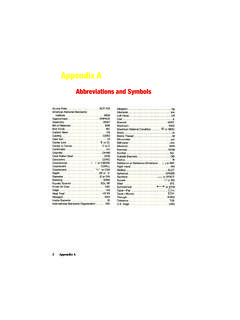Transcription of Practical Hydraulics Course - Fluid Power Education ...
1 Fluid Power Training Institute 2170 South 3140 West Salt Lake City, UTAH 84119 United States of America Practical Hydraulics Workshop for Mobile and Industrial Systems Practical Hydraulics Workshop 40 hours The Practical Hydraulics Workshop in Mobile and Industrial Hydraulics covers the following topics: 1. Safety 2. hydraulic symbols 3. Basic hydraulic Laws and Principles 4. Pressure Control Valves 5. hydraulic Pumps and Closed-loop (hydrostatic) Systems. 6. Check Valves, Accumulators, and Actuators. 7. Reservoirs, Coolers, Hoses, and Connectors 8. Directional Control Valves 9. Flow Control Valves 10. Flow Dividers The workshop includes extensive trainer exercises as outlined in the Trainer Activities Booklet located in the back of the Workshop Manual.
2 Practical Hydraulics Workshop Course Syllabus 1 - Safety 1) Describe at least six typical accidents associated with Hydraulics . Describe how and why they occur, and, describe what steps must be taken to prevent them. 2) Describe why exhausting high-pressure oil to atmosphere can lead to severe injury, death, or substantial property damage. 3) Describe what conditions can lead to a high-pressure injection injury. 4) Describe what steps to take in the event of suffering a high-pressure injection injury. 5) Explain what steps must be taken to make a hydraulic system safe to work on. 6) Describe OSHA s/MSHA s six-step lockout and tagout procedure. 7) Describe how to safely bleed air from a hydraulic system.
3 8) Explain how a flow meter, pressure gauge, and temperature gauge can be used to prevent accidents. 9) Explain how to safely tighten a leaking connector. 10) Explain the potential consequences of tightening a leaking connector while it is under pressure. 11) Explain how to safely de-energize a hydraulic system. 12) Explain the potential consequences of de-energizing a hydraulic system to atmosphere. 13) Explain why it is dangerous to attempt to stall the output shaft of a hydraulic motor. 14) Describe what steps to take before using a high-pressure porta- Power . 15) Describe why only trained, authorized personnel should be permitted to service, repair, and charge an accumulator. 16) Describe why only trained, authorized personnel should be permitted to make high-pressure hose assemblies.
4 17) Describe why using compressed air to disassemble a hydraulic cylinder can lead to severe injury, death, or substantial property damage. 18) Describe the correct technique for removing a stubborn gland when disassembling a hydraulic cylinder. 19) Describe at least five design features that will make a hydraulic system safe to service, repair, and troubleshoot. 2 - hydraulic symbols 1) Correctly describe the meanings of: a) a complete graphic symbol b) a simplified graphic symbol c) pictorial symbol. d) cutaway symbol e) graphic symbol 2) Correctly describe the six elements of the scope of the symbol standard. 3) Correctly describe the four elements of the purpose of the symbol standard.
5 4) Correctly describe the three symbol rules. 5) Correctly describe the five shapes that are used to make Fluid Power symbols . Correctly describe what the following shapes represent: a) Circles b) Squares c) Diamonds d) Rectangles 6) Correctly describe what the four basic types of lines represent. 7) Correctly describe what the acronyms ISO and ANSI mean. 8) Identify on a schematic, and correctly interpret the following groups of symbols : a) Pumps b) Pressure control valves c) Directional control valves. d) Accumulators e) Flow control valves f) Check valves. g) Fluid conditioners h) Actuators i) Measuring instruments 9) Use the ANSI and/or ISO symbol reference manual to look-up a symbol.
6 3 - Basic hydraulic Laws and Principles (approximately 6-hours includes trainer time) 1) Describe Pascal s Law and explain how it revolutionized the hydraulic industry. 2) Explain what hydraulic Power is. 3) Give at least six advantages of using hydraulic as opposed to other means of Power transmission. 4) Describe the effect pressure and flow have on hydraulic horsepower. 5) List the six primary components in a hydraulic system and describe their respective purposes. 6) Describe the primary difference between a positive and non-positive displacement pump. 7) Explain the meaning of positive displacement. 8) Explain the two methods used to describe pump volume. 9) Describe what elements must be known to calculate pump flow.
7 10) Describe how to calculate pump flow when displacement and speed are known. 11) Explain the difference between theoretical pump flow and actual pump flow. 12) Explain what pump volumetric efficiency means. 13) Recite the volumetric efficiencies (by rule-of-thumb) of the following pumps: a) Piston b) Vane c) Gear 14) Recite three diagnostic instruments needed to safely and accurately determine pump flow. 15) Describe how a regeneration circuit works. 16) Describe what occurs when oil is flowing in parallel flow paths. 17) Explain why a hydraulic cylinder can be compared to a 3-speed mechanical transmission. 18) Describe what components determine maximum force/torque output of a hydraulic system.
8 19) Describe, using a diagram, the primary components which make up a hydraulic cylinder. 20) Explain what causes pressure in a hydraulic system. 21) Describe the two sources of pressure in a hydraulic system. 22) Explain how to determine if oil is flowing using pressure gauges. 23) Explain the point-to-point resistance which a pressure gauge can read. 24) Describe the difference between system-generated pressure and load-generated pressure. 25) Describe the difference between flow and velocity 26) Describe Pascal s Law and explain how it applies to a hydraulic system. 4 - Pressure Control Valves (approximately 6-hours includes trainer time) 1) List the five types pressure control valves 2) Describe the basic operation of a pressure control valve 3) Describe the two components which determine the pressure setting of a pressure relief valve 4) Explain the difference between an unguided poppet type and a guided poppet type relief valve 5) Describe the differences between parallel and series circuits 6) Describe what occurs when two or more pressure relief valve are connected in series.
9 7) Describe the meaning of Power -beyond. 8) Explain what a Power -beyond option achieves in a directional control valve. 9) Skill Drill Correctly set a pressure relief valve at a pressure specified by a system designer. 10) Describe the single most important safety consideration when installing a pressure relief valve in a circuit. 11) Explain what will happen if a pressure relief valve is incorrectly installed (ports reversed) in a circuit. 12) Describe the correct safety procedures for setting a pressure relief valve. 13) Explain what must be done to safely create the resistance necessary to set a pressure relief valve. 14) Select the correct pressure gauge, know where to install it in the circuit, and know how to use it to correctly set a pressure relief valve.
10 15) Recognize the symbol for a pressure relief valve from a line-up of pressure control valve symbols . 16) Describe the primary purpose of a sequence valve 17) Describe the main difference between a pressure relief valve and a sequence valve. 18) Describe why a sequence valve must be externally drained. 19) Recite the three basic rules for setting pressure control valves when there are two or more in a circuit. 20) Describe the basic steps you must follow to safely and correctly set a sequence valve. 21) Describe the primary purpose of a counterbalance valve 22) Describe the basic operation of a counterbalance valve 23) Explain the two primary applications of a counterbalance valve. 24) Describe at least four purposes of a counterbalance valve.








